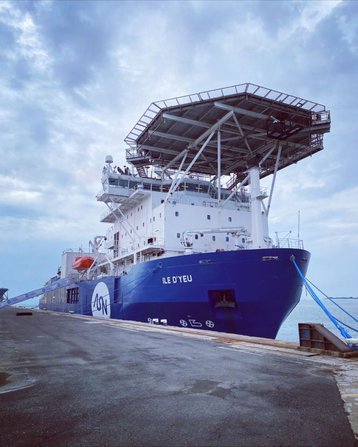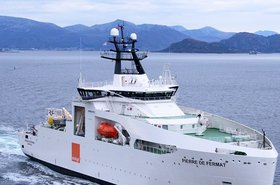Alcatel Submarine Networks (ASN) has launched a new cable ship.
The company recently announced the inauguration of the Ile d'Yeu, a new cable installation vessel, at the Port of La Rochelle in France.
The new ship is ASN’s seventh cable ship overall, and fifth dedicated to laying cables.
The Ile d'Yeu was delivered in partnership with Louis Dreyfus Armateurs, which said it has the world's biggest cable loading capacity.
Originally built in 2001, the 148-meter long, 27m wide vessel can reportedly hold load 8,500+ tonnes of cable in a single voyage, equating to 15,000km of cable.
The ship’s first deployment is set to be laying the Meta-led Bifrost cable between the US and Singapore.
Last year ASN launched the Ile de Molène, a new cable maintenance vessel. The ship was previously a former supply vessel built in 2006.
ASN acquired both the Ile de Molène and the Ile d'Yeu in 2021. The latter was originally set to join ASN’s fleet at the end of 2022.
Subsea cable boom means more ships needed
Despite there being more than 400 subsea cables in operation or development, there are only around 60 cable ships in the world designed to lay and maintain them. After a splurge of investment around the turn of the century, there were no new build cable ships delivered between 2004 and 2010, and only five ships were delivered between 2011 and 2020.
Less than 10 of those 60 ships are younger than 18, with most between 20 and 30 years old. 19 are over 30 years old, and one is over 50; the Finnish Telepaatti, which was built in 1978.
The cable ship capacity crunch is seeing many projects delayed, and some re-routed. Last year ASN told DCD the company was fully booked until 2024. The shortage of available ships is also forcing smaller projects to secure funding ahead of time before they can secure capacity on a vessel.
Despite the glut of new cables, new vessels are rare. Ships can cost more than $100 million to develop, and operators are reluctant to invest in new tonnage. But a number of operators are repurposing older ships to save costs.
Last year saw SBSS launch a new cable ship, the Fu Tai. Built in Spain in 2007 as an offshore construction vessel, SBSS purchased the Fu Tai in 2021 and converted her to a bespoke vessel.
South Africa’s Mertech Marine last year announced the retirement of the cable retrieval ship MV Lida. It plans to replace the vessel but hasn’t made any announcements yet.
Despite the cable ship crunch, at least two cable ships are set to enter service in 2023. Orange Marine’s newest vessel, the newly-built Sophie Germain, recently left dry dock in Sri Lanka to sail to France for its final fit-out.








